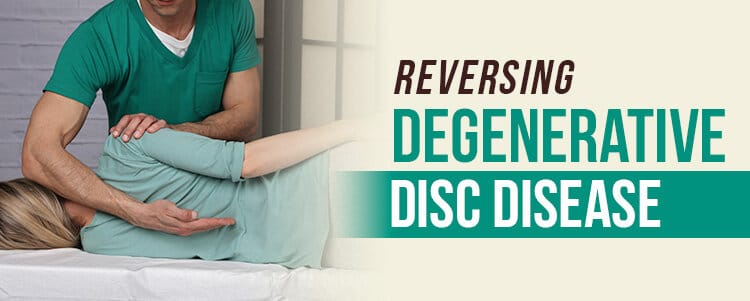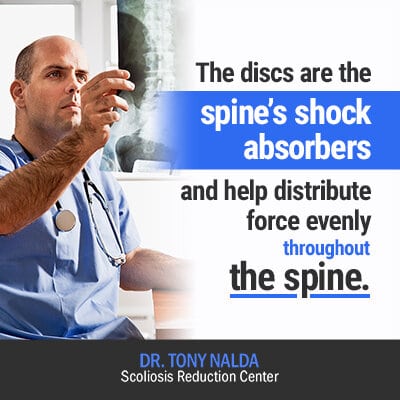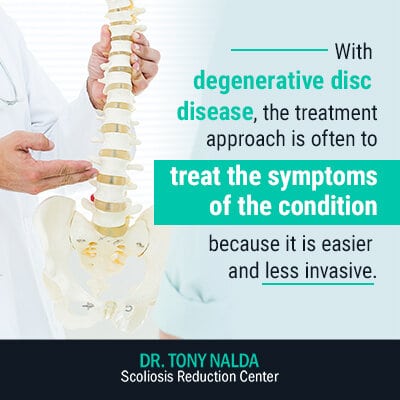
The truth of the matter is that degenerative disc disease is neither a disease, nor can it be reversed. Despite its name, it’s not something you can catch or acquire from someone else; it’s a condition that develops because of an asymmetry in the spine. While the condition cannot be fully reversed, efforts can be made to control its progression and promote some regeneration.
Treating degenerative disc disease involves controlling its progression. Depending on the approach, you can either treat it as a condition, or address its actual cause. The only way to come close to reversing it is by treating the condition’s underlying cause, which is a lot more complicated than treating the symptoms of the condition. Before we get into the difference between these approaches, let’s first discuss the roles of the spinal discs and define degenerative disc disease.
Table of Contents
The spine is made up of individual bones (vertebrae) that are stacked on top of one another. Each individual vertebra is separated by a disc, and those discs play important roles in maintaining a healthy spine.
The discs act as cushions between each vertebra so they are not rubbing against each other. The disc’s outer portion is hard and durable, while the disc’s inner portion is soft and squishy.

The discs are the spine’s shock absorbers and help distribute force evenly throughout the spine. They also act as tough ligaments that keep the vertebrae of the spine aligned and together. The discs are also cartilaginous joints that help enable the spine to bend and twist.
With these things in mind, you can see how essential the discs are in keeping the spine healthy and mobile.
When a person develops scoliosis, this means their spine has an abnormal sideways curvature that also rotates. This misalignment of the spine causes numerous problems with the spine’s biomechanics as there are a lot of uneven forces at play, such as adverse spinal tension.
When a spine slips out of alignment, the uneven forces cause the discs to degenerate faster than in a healthy spine that can evenly distribute force. This uneven pressure causes damage to the discs, meaning that cushioning effect is compromised and the vertebrae are going to rub together.
The more misaligned the spine is, the more damaged the discs are, and the more damaged the discs are, the more misaligned the spine becomes. A misaligned spine can’t absorb and distribute force evenly and starts to impact the spine’s flexibility.
Common symptoms of degenerative disc disease include mobility issues, back pain, and pain that radiates into the neck, arms, legs, sciatica, and hips.
The big problem, in terms of treating degenerative disc disease, is that the discs don’t have their own blood supply or many nerve endings; this is why they don’t have the ability to repair themselves and disc degeneration develops into a chronic progressive condition.
While it is possible to treat the condition by addressing the cause, this means treating and correcting, as much as possible, the misalignment of the spine. The effects of disc degeneration due to scoliosis are cumulative, just as the effects of treating scoliosis is a lengthy process that has to achieve a structural change that’s sustainable.
Let’s now make the distinction between the two approaches to treating degenerative disc disease: treating the condition versus treating the underlying cause.
There is a big distinction between treating a condition and treating the cause of that condition, and what it boils down to is whether or not the main focus of treatment is addressing the symptoms of the condition, or its underlying cause.
When it comes to treating degenerative disc disease, to better understand the mechanics of the condition, I like to use the analogy of a misaligned car. If one tire wears out faster than the others, it’s not that there’s something wrong with the tire itself; it’s that there is an asymmetrical load causing uneven wear on those tires. It’s a similar situation with a misaligned spine. The misalignment is the underlying cause of the degeneration that a disc is experiencing.
While we know that the aging process can cause degeneration of the spine, we also know it’s not solely age that causes this because if it was, then every disc in the spine would wear in exactly the same way; instead, the most disc degeneration is always at the site of misalignment.
So the way to potentially reverse the effects of degenerative disc disease as much as possible is to address the underlying cause: weight-bearing issues due to misalignment.
The problem with degenerative disc disease in scoliosis patients is that we’re never going to get a perfect alignment, which is why we can never completely reverse the disc degeneration that has cumulatively developed as the scoliosis has progressed.

With degenerative disc disease, the treatment approach is often to treat the symptoms of the condition because it is easier and less invasive.
Treating degenerative disc disease symptoms would include medications, surgery, and injections into the discs. These help address the number-one reason most patients seek medical help: pain.
There are numerous things that can be done to address symptoms of the condition, and from a medical perspective, it makes sense to focus on the condition’s symptoms for as long as possible because addressing the underlying cause is a far more lengthy and complex process.
As discussed, the only way to potentially achieve some reversal of the condition’s effects is to address the structural issue of the misalignment at its root.
The straighter a spine is, the better it’s going to function and the less it’s going to deteriorate over time.
So if we address the degenerative disc disease by addressing its cause, this means correcting the spine’s misalignment as much as possible, at a structural level.
While it takes a comprehensive treatment plan and a lot of work and commitment from the patient, when we achieve a curvature reduction and restore as much of the spine’s healthy curves as possible, we are improving that misalignment on a structural level and addressing the cause.
What it takes is removing that asymmetrical load off those discs as much as possible and for as long as possible, which means the work continues after the curvature is reduced to sustain those results.
If we are able to reduce the scoliosis and correct the misalignment enough, the discs do have the ability to recover and regenerate somewhat; however, as the effects of disc degeneration are cumulative, so too is the process of working to correct them.
Regeneration of the discs can be possible if the condition is caught early on before a lot of progression has taken place, but it takes long periods of time and treatment of the underlying cause. There is no quick fix or process that can simply restore the function of the spinal discs that has been lost over time.
Here at the Scoliosis Reduction Center, our approach is always to treat the actual cause of the condition, and not just its symptoms. We have the experience and tools available to achieve structural changes to the spine.
This approach of engaging with our patients to come up with a sustainable and effective treatment plan is the way we work towards correcting misalignments of the spine and their symptoms, such as disc degeneration.
While many people choose to simply address the symptoms of disc degeneration that they find the most disruptive, like pain, this is going to do nothing in terms of actually reversing the degeneration and addressing its underlying cause.
While certain levels of reversal are possible, and I’ve even seen some patients’ discs regain some of their function over time, it doesn’t happen without a lot of time and active effort.
When it comes to disc degeneration due to scoliosis, this is even harder to reverse as scoliosis is progressive and incurable. While we can treat scoliosis by controlling its progression, achieving a curvature reduction, and restoring as much as the spine’s healthy curves as possible, the spine will never be perfectly aligned again.
Degenerative disc disease is a condition that compromises the health and function of the spine; in order to treat it effectively with long-term results, the underlying cause of the misalignment has to be addressed and treated on a structural level.
